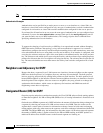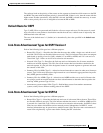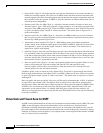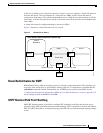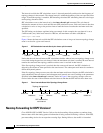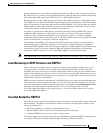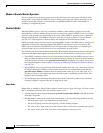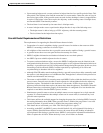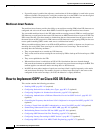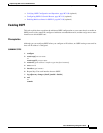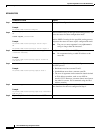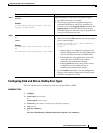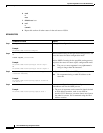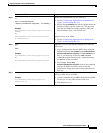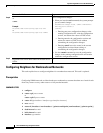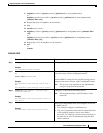
Implementing OSPF on Cisco IOS XR Software
How to Implement OSPF on Cisco IOS XR Software
RC-144
Cisco IOS XR Routing Configuration Guide
• If graceful restart is enabled, the adjacency creation time of all the neighbors is saved in the system
database (SysDB). The purpose for saving the creation time is so that OSPFv3 can use the original
adjacency creation time to display the uptime for that neighbor after the restart.
Multicast-Intact Feature
The multicast-intact feature provides the ability to run multicast routing (PIM) when IGP shortcuts are
configured and active on the router. Both OSPFv2 and IS-IS support the multicast-intact feature.
You can enable multicast-intact in the IGP when multicast routing protocols (PIM) are configured and
IGP shortcuts are configured on the router. IGP shortcuts are MPLS tunnels that are exposed to IGP. The
IGPs routes IP traffic over these tunnels to destinations that are downstream from the egress router of
the tunnel (from an SPF perspective). PIM cannot use IGP shortcuts for propagating PIM joins because
reverse path forwarding (RPF) cannot work across a unidirectional tunnel.
When you enable multicast-intact on an IGP, the IGP publishes a parallel or alternate set of equal-cost
next-hops for use by PIM. These next-hops are called mcast-intact next-hops. The mcast-intact
next-hops have the following attributes:
• They are guaranteed not to contain any IGP shortcuts.
• They are not used for unicast routing but are used only by PIM to look up an IPv4 next-hop to a PIM
source.
• They are not published to the FIB.
• When multicast-intact is enabled on an IGP, all IPv4 destinations that were learned through
link-state advertisements are published with a set equal-cost mcast-intact next-hops to the RIB. This
attribute applies even when the native next-hops have no IGP shortcuts.
• In OSPF, the max-paths (number of equal-cost next-hops) limit is applied separately to the native
and mcast-intact next-hops. The number of equal cost mcast-intact next-hops is the same as that
configured for the native next-hops. (In IS-IS, the behavior is slightly different.)
How to Implement OSPF on Cisco IOS XR Software
This section contains the following procedures:
• Enabling OSPF, page RC-145 (required)
• Configuring Stub and Not-so-Stubby Area Types, page RC-147 (optional)
• Configuring Neighbors for Nonbroadcast Networks, page RC-150 (optional)
• Configuring Authentication at Different Hierarchical Levels for OSPF Version 2, page RC-155
(optional)
• Controlling the Frequency that the Same LSA Is Originated or Accepted for OSPF, page RC-158
(optional)
• Creating a Virtual Link with MD5 Authentication to Area 0 for OSPF, page RC-160 (optional)
• Summarizing Subnetwork LSAs on an OSPF ABR, page RC-164 (optional)
• Redistributing Routes from One IGP into OSPF, page RC-166 (optional)
• Configuring OSPF Shortest Path First Throttling, page RC-170 (optional)
• Configuring Nonstop Forwarding for OSPF Version 2, page RC-173 (optional)
• Configuring OSPF Version 2 for MPLS Traffic Engineering, page RC-175 (optional)



